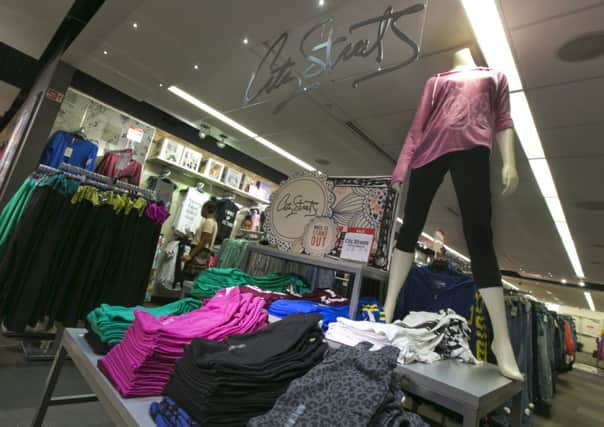Americans shunning jeans for ‘yoga pants’


Jeans long have been a go-to staple in closets across the country. After all, not many pieces of clothing are so comfortable they can be worn daily, yet versatile enough to be dressed up or down.
But sales of the iconic blues fell 6 percent during the past year after decades of almost steady growth. Why? People more often are sporting yoga pants and leggings instead of traditional denim.
Advertisement
Hide AdAdvertisement
Hide AdThe shift is partly due to a lack of new designs since brightly coloured skinny jeans were a hit a couple years back. It’s also a reflection of changing views about what’s appropriate attire for work, school and other places that used to call for more formal wear.
“Yoga pants have replaced jeans in my wardrobe,” said Anita Ramaswamy, a Scottsdale, Arizona high-school senior who is buying more leggings and yoga pants than jeans. “You can make it as sexy as skinny jeans and it’s more comfortable.”
To be sure, the jeans business isn’t dead: Customer Growth Partners, a retail consultancy, estimates denim accounts for 20 percent of annual sales at the nation’s department stores.
But sales of jeans in the US fell 6 per cent to $16 billion during the year that ended in June, according to market research firm NPD Group, while sales of yoga pants and other “active wear” climbed 7 per cent to $33.6 billion.
And Levi Strauss, which invented the first pair of blue jeans 141 years ago, is among jean makers that acknowledge their business has been hurt by what the fashion industry dubs the “athleisure” trend. That’s led them to create new versions of classic denim that are more “stretchy” and mimic the comfort of joggers.
It’s one of the few times jeans haven’t been at the forefront of what’s “trending.” Businessman Levi Strauss and tailor Jacob Davis invented jeans in 1873 after getting a patent to create cotton denim work trousers with copper rivets in certain areas like the pocket corner to make them stronger. By the 1920s, Levi’s original 501 jeans had become top-selling men’s trousers, according to Levi’s corporate website.
Over the next couple of decades, the trousers went mainstream. In 1934, Levi’s took advantage of the rise in Western movies and launched its first jeans aimed at affluent women who wanted to wear them on dude ranches. Then teens boosted popularity of the trousers, first among the greasy-hair-and-leather-jacket set in the 1950s and then, the hippies in the 1960s.
But teens’ biggest contribution to jeans’ rise was the name itself: Until the 1950s, the trousers were called overalls or waist overalls, but in the following decade, teens started referring to them as jeans. During that time, jeans took on a bad-boy image - popularised by teen rebels like James Dean and Marlon Brando - which led many schools to ban kids from wearing them to class.
Advertisement
Hide AdAdvertisement
Hide AdIn 1960, Levi’s began using the `jeans’ name in ads and packaging. And over the next few decades, jeans became even more of a way for people to express themselves. In the 1960s to early 1970s, hip-huggers and bell bottoms became an anti-establishment statement. Then in the 1970s and early 1980s, jeans became a status symbol when designers like Jordache rolled out more chic versions. More recently, names like 7 For All Mankind made $200 jeans, helping to push sales up by 10 per cent to $10 billion in 2000, NPD said.
Jeans have faced other rough patches. One came in the mid-1970s, when denim sales fell 3 to 4 percent, while corduroy trousers surged in popularity, with sales rising 10 to 12 percent, according to NPD estimates.
NPD declined to offer more historical sales data because of changes it made in its methodology recently, but the group’s chief industry analyst Marshal Cohen says jean sales fell about 3 percent again with the resurgence of khakis 12 years ago. That was the last decline until now.
Fashion watchers say the latest decline could be the longest. The “athleisure” trend is the biggest threat jeans have faced because it reflects a fundamental lifestyle change, said Amanda Hallay, assistant clinical professor of fashion merchandising at LIM College in Manhattan. “Everyone wants to look like they’re running to the gym, even if they’re not,” she said.
As a result of jeans’ waning popularity, retailers and designers are focusing more on activewear and less on denim. For instance, JC Penney recently has doubled its selections in casual athletic looks and scaled back growth of its denim business.
And designers are pushing new versions of jeans. Both Levi’s and VF Corp., the maker of Wrangler and Lee jeans, are rolling out jeans that they say are stretchier. And many brands are making so-called jogger trousers, a loose-fitting, joggers style that has elastic cuffs at the bottom of the leg.
“If casualisation is what everyone is looking for, we can push the innovation,” said James Curleigh, president of the Levi’s brand.
It’s too early to tell whether the new styles will help jeans regain popularity. Jennifer Romanello, for one, said she’s not interested in them.
“If I want yoga pants, I will buy yoga pants,” said the publishing executive from Rockville Centre, New York. “I just don’t see jeans crossing the line to be yoga pants.”